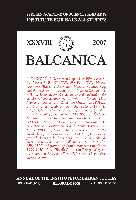The Introduction of a Limping Standard in the Principality of Serbia
The Introduction of a Limping Standard in the Principality of Serbia
Author(s): Dragana GnjatovićSubject(s): History
Published by: Balkanološki institut - Srpska akademija nauka i umetnosti
Keywords: Ottoman Empire; Serbia; monetary autonomy;
Summary/Abstract: From the Ottoman conquest in 1459 to the monetary reform launched in 1868, Serbia was under the full monetary suzerainty of the Ottoman Empire and did not have the right to mint her own coinage. The first half of the nineteenth century, however, saw the first signs of monetary autonomy. When in 1815 the Porte granted Serbian authorities the right to collect taxes, currency exchange rate lists began to be issued in Serbia determining the kind and price of foreign currencies acceptable for tax payment. When, in accordance with the hatti-sherifs of 1830 and 1833, Serbia’s vassal taxes to the Ottoman Empire were united into a single monetary tribute to be paid annually in gold currencies, a dual accounting monetary unit was introduced as protection from Ottoman debased silver currency. A true monetary autonomy, however, was only achieved with the monetary reform carried out between 1868 and 1880, when a limping gold standard in accordance with the standards of the Latin Monetary Union was introduced de iure. After more than four centuries of using only foreign currencies in circulation, the minting of silver coins was reestablished in Serbia and a Serbian gold coin was minted for the first time. While adopting the minting standards of the Latin Monetary Union, Serbia had never become a member.
Journal: BALCANICA
- Issue Year: 2007
- Issue No: 38
- Page Range: 91-105
- Page Count: 14
- Language: English

